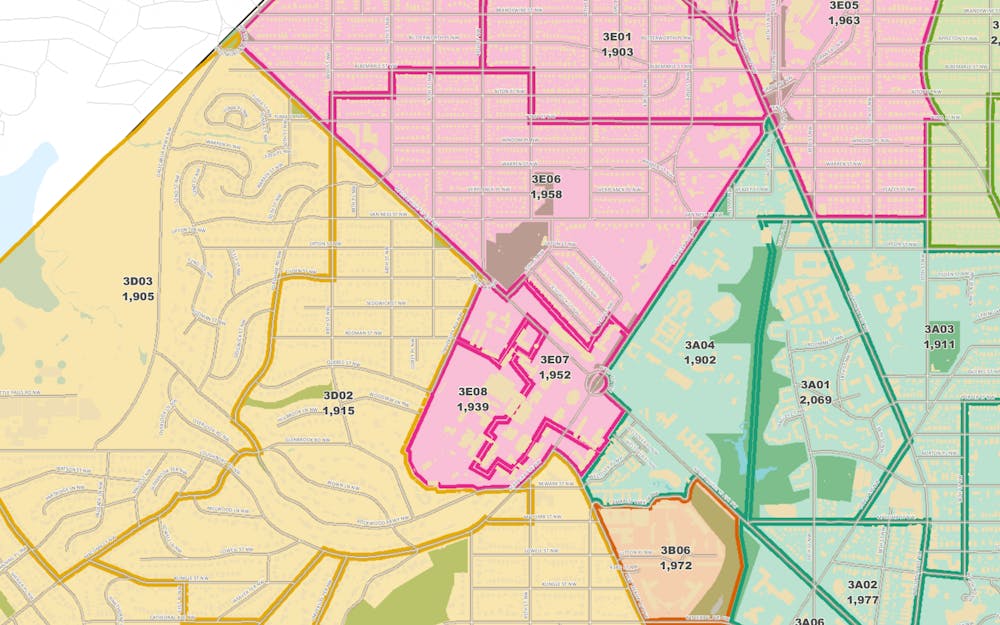American University will gain a second Advisory Neighborhood Commissioner and move from ANC 3D to ANC 3E under the Ward 3 redistricting proposal currently being considered by the D.C. Council.
The two major changes to how AU is represented in local politics reflect the growing population of the student body — and its expanded influence — since the last redistricting took place after the 2010 census.
By moving AU to ANC 3E, the Ward 3 ANC Redistricting Task Force signaled agreement with AU’s current ANC commissioner, Christian Damiana, that students are more closely oriented to Tenleytown than Spring Valley and thus should have more representation there.
The task force’s map and companion 120-page report detailing their decisions, which was unveiled in early April, is the result of several months of deliberations and extensive public comment.
“The voice of the two AU student commissioners will have more weight, and we thought that was the right thing to do,” Task Force Chair Jerry Malitz said of the redrawn map.
Advisory Neighborhood Commissions are the most hyperlocal political bodies in D.C. Each of the city’s eight wards has multiple ANCs, each of which is given a letter name, like 3D or 3E in Ward 3. Each ANC is made up of single-member districts represented by one commissioner. There’s no set number of districts per ANC, but most have around six or seven. In the newly drawn map, ANC 3E will have eight single-member districts. AU will have two commissioners — likely to both be current students — because its campus will be split into 3E07 and 3E08.
Damiana, a senior in AU’s School of Public Affairs, lobbied the task force to split the University’s campus into two districts and said the new map gives long-overdue representation to students. He said he proposed a version of the map that was essentially the same as what the task force ultimately adopted, though he had no formal role in drawing the district lines.
The map that’s been in place for the last decade has AU’s campus as a single district, which Damiana said means he represents about 3,500 people. That’s significantly more than the average of 2,000 people that each commissioner is supposed to represent. The redistricting task force’s map puts the two new campus districts at just over 1,900 students each.
In an email, AU spokesperson Elizabeth Deal said the University was not involved in the redistricting process and does not have a position on the new map.
American University Student Government did not take a position either, though they recently created a local government liaison position to streamline communication with the ANCs. No one has been appointed yet to serve in that role.
Giving AU students more representation in local politics is widely seen as a commonsense move by the task force, according to public comment submissions on the process as well as neighbors from the area. The more contentious change is the decision to move AU from ANC 3D, which includes Spring Valley and Wesley Heights, to 3E, which is centered in Tenleytown and Friendship Heights.
Tom Smith, a former ANC 3D commissioner and three-time veteran of the redistricting task force, said the decision to move AU to 3E is a shortsighted mistake.
“It’s disenfranchising students,” said Smith. He added that AU will no longer have representation when residents of Spring Valley and Wesley Heights, the two neighborhoods that directly border campus, go to their ANC with concerns about students.
“Those issues are going to be discussed without a student at the table as a commissioner for AU, and I think that's unfair,” said Smith, who was not involved in this round of redistricting. “I think that defeats the whole purpose of engaging students in local and neighborhood issues.”
Smith also pushed back on Damiana’s assertion that students should be represented in 3E because of their connection to Tenleytown.
“People aren't put into an ANC based on where they work or where they socialize — it’s the neighborhood in which they live,” he said. “And the students who live on the main campus basically live in the Spring Valley neighborhood.”
Malitz, the task force chair, said those are “false flag concerns” and “totally bogus.” Because ANCs publish their agendas in advance and all meetings are open to the public, he said AU students could go to 3D meetings any time there’s an issue that affects them, even if it’s no longer the ANC they live in.
“Nobody loses a voice,” Malitz said. “In fact, it's encouraged that people who are affected by what’s being discussed are there to discuss it.”
Another concern Smith has about the new map is that it splits AU students living off-campus into several ANCs. While task force members wrote in their report that their proposal ensures “student residents living on Nebraska Avenue, in AU Park and in Tenleytown will be in the same ANC as the University itself,” the apartment buildings on Massachusetts Avenue where a large share of AU students live will be split into different ANCs.
Under the current map, the Avalon, Berkshire and Foxhall apartment buildings all fall into 3D with AU’s campus, concentrating the majority of AU students in one ANC. But the new map moves the Berkshire and Foxhall to ANC 3A and the Avalon to ANC 3B, splitting AU students between at least three different ANCs.
Damiana said he doesn’t see that as a significant issue because, as AU’s commissioner, he advocates for all of the University’s students, even though he legally only represents those who live on campus. Plus, a student living in one of those apartment buildings could run for ANC as easily as a student living on campus, opening up the possibility that an AU student could serve as a commissioner in 3A or 3B.
Smith, in a letter he wrote to the D.C. Council Subcommittee on Redistricting and shared with The Eagle, said the decision to split the apartments from campus “effectively dilutes the overall ability of students to have representation within the ANC governance process.”
Debates over the new map will continue at least through the summer, as the D.C. Council Subcommittee on Redistricting and then the full Council takes up each Ward’s proposed maps. The subcommittee already held one day of hearings on the proposals on April 7 and has another hearing scheduled for April 28. A vote to advance the maps is expected from the subcommittee in May or June, at which point the full D.C. Council will debate and vote on whether to approve them for use.





